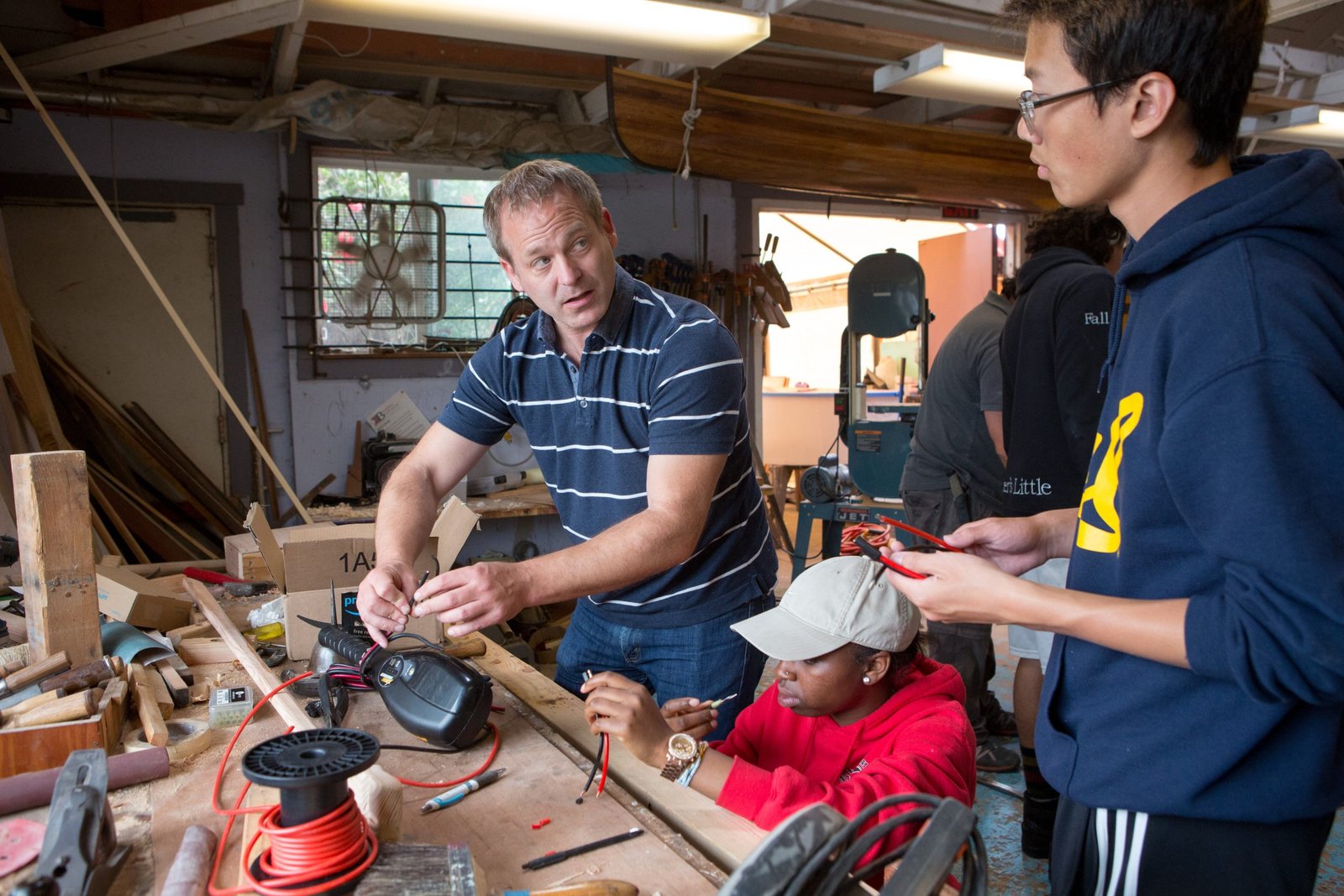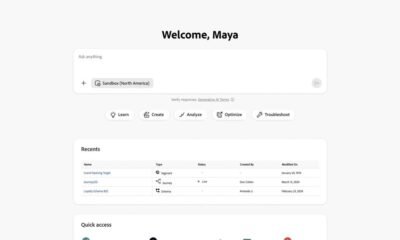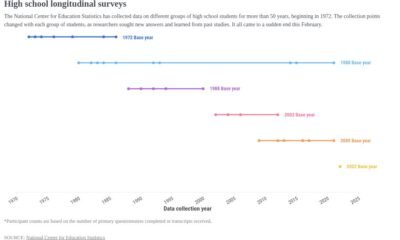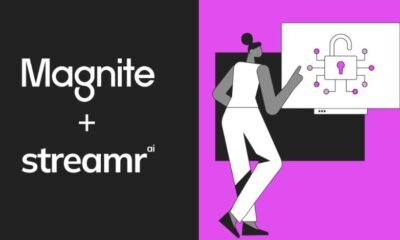Education
NAEP scores show we need new approaches, more resources and all hands on deck to address underlying education problems

America’s future is not made in factories or innovation labs — it’s forged in classrooms. We can’t bring good jobs back to U.S. shores if we don’t first educate a workforce capable of doing them. The latest National Assessment of Educational Progress, or NAEP, known as the Nation’s Report Card, paints a grim picture, with test scores down since 2019 for eighth graders in science and 12th graders in math and reading.
The lowest-performing learners lost the most ground, leaving large percentages of students unable to perform the strong academic work required for postsecondary life. Only about 1 in 5 high school seniors scored at the NAEP Proficient level in math. That puts them at a terrible disadvantage since STEM positions make up a growing percentage of the workforce. Nearly half were working below even the NAEP Basic level, meaning they likely don’t know how to use percentages to solve real-world problems.
This isn’t the first bad report card we’ve seen since the pandemic upended learning five years ago, but progress in American education has generally been stalled for at least a decade. Leaders at every level need to stop using the pandemic as an excuse and start looking for solutions. There have been times in the past when Republicans and Democrats have come together around education. While that may be difficult to do today, it’s needed more than ever.
Related: A lot goes on in classrooms from kindergarten to high school. Keep up with our free weekly newsletter on K-12 education.
We need new approaches, more resources and all hands on deck to help students develop the knowledge and skills to thrive in an increasingly complicated world. The teens who took the 12th grade tests are now out of school. They’re facing a workforce disrupted by AI and demanding more from them — not less. Even young people who opt not to go to college, such as those looking to work in manufacturing, for example, need more advanced STEM and literacy skills than in the past.
There are some areas of educational progress around the country we can learn from. For example, Indiana is remaking the American high school experience to personalize it and connect it to the world of work, while Rhode Island is reinvigorating career and technical education to embed it with more rigor and ensure it provides an on-ramp to an array of postsecondary options, including college.
We can also expand on the reforms that are taking root in elementary education. An emphasis on the research behind teaching children to read, sometimes referred to as the science of reading, is effective. And states like Mississippi and Louisiana, leaders in this movement, have seen strong literacy gains. We can apply that kind of evidence-based approach across K-12 subjects and grades.
It’s also vital to listen to what students are saying. Fortunately, the Nation’s Report Card can help with this.
Survey data accompanying the eighth grade science assessment suggests that inquiry-based learning is in decline. Fewer students say they’re spending time on things like designing experiments to answer research questions. That kind of instruction helps students build science knowledge and develop key skills like the ability to think critically and to collaborate with peers, exactly the kind of skills that AI can’t replace.
Related: Nation’s Report Card at risk, researchers say
The best instruction has a purpose for learning, explores real-world problems and makes connections to work. Most states have passed science standards that promote this kind of instruction, but more resources are needed to get aligned materials into schools and provide teachers with the training to use them effectively.
Getting kids out of the classroom helps too. I invited elementary school students to my farm in western Massachusetts a few years ago and vividly recall a fourth grader’s aha moment, finally understanding decimals when collecting 2.25 inches of rain in a vial. It was a terrific example of how interdisciplinary science is and how powerful it is in experiential learning settings.
It’s true that science resources, such as lab materials, can be expensive; however, schools can tap into community partners and business leaders for assistance. In Massachusetts, for example, General Electric has helped bring mobile technology labs into schools.
One thing I am grateful for, even amid all this bad education news, is the high-quality data shining a light on the problems we’re facing. There are too many voices today calling for a rollback of testing. That’s a mistake. Obtaining meaningful data, such as that found on the Nation’s Report Card, is crucial. Of course, what we do with it matters even more.
It has been 42 years since American leaders from across political parties and sectors came together to bring attention to “A Nation at Risk,” a landmark report that spurred significant education reforms. And it’s been 36 years since 49 governors came together and defined the state role in K-12 schooling.
After these milestones, the nation saw sustained progress on NAEP. We need that same leadership now.
Republican Jane Swift is a former governor from Massachusetts who serves on the National Assessment Governing Board, which oversees the Nation’s Report Card. She is also the CEO of Education at Work, a nonprofit that connects college students with work-based learning opportunities.
Contact the opinion editor at opinion@hechingerreport.org.
This story about NAEP scores was produced by The Hechinger Report, a nonprofit, independent news organization focused on inequality and innovation in education. Sign up for Hechinger’s weekly newsletter.
Education
Harnessing AI thoughtfully will be critical to prepare for tomorrow’s workforce, says US Education Secretary Linda McMahon: Here’s what students must learn

The American classroom is standing at a historic crossroads. For decades, the defining debates in education were about funding formulas, standardized tests, and curriculum design. Now, as artificial intelligence (AI) reshapes industries at a pace unseen since the Industrial Revolution, the urgent question is not whether schools should adopt technology—but how they should wield it responsibly to prepare the workforce of tomorrow.That was the core message delivered yesterday by U.S. Secretary of Education Linda McMahon during her visit to Austin, Texas, a stop on her Returning Education to the States Tour. Touring Alpha School—a private K–8 institution that has embedded AI into its instructional model—McMahon witnessed firsthand how algorithms can tailor learning to a child’s individual pace and strengths. Later, at the University of Austin, she sat down with President Carlos Carvalho to explore how higher education is cultivating innovation in the age of machine intelligence.“Harnessing AI thoughtfully will be critical to expanding opportunity and preparing students for tomorrow’s workforce,” McMahon said in a press release. “During my visit to Austin, I saw how AI can open doors, but also how curiosity, critical thinking, and open debate that drive learning. As we return education to the states, it’s vitally important that innovation is guided by the fundamentals, so that the classroom remains a true marketplace of ideas.”Her words carry weight at a moment when both the promises and perils of AI in education are becoming more visible. Proponents see AI as a force multiplier, personalizing instruction, automating routine tasks for teachers, and exposing students to digital tools they will inevitably encounter in future careers. Critics, however, warn of algorithmic bias, privacy concerns, and the risk of reducing education to data-driven efficiency rather than human inquiry.McMahon’s choice of Austin as a showcase is telling. The city is fast becoming a national hub for tech-driven education reform. Alpha School has built its reputation on leveraging AI platforms that adapt in real time to student performance, freeing teachers to focus on mentorship rather than rote instruction. The University of Austin, still young but already carving out a niche as an innovation-focused institution, is experimenting with ways to integrate ethics and humanities into technical training—reminding students that technological progress must be anchored in human values.Texas Education Commissioner Mike Morath, who joined the Secretary during her visit, underscored the point: “I am grateful to have joined Secretary McMahon at today’s visit and appreciated the thoughtful discussion on the responsible use of innovation in schools. At the Texas Education Agency, we are always searching for transformational best practices that can be shared with Texas public schools to help them best meet the needs of students and help our dedicated educators focus on what they do best – teaching,” as reported in a press release of US.
What students must learn in the AI era
McMahon’s remarks touch on a critical recalibration. The workforce of tomorrow will require a blend of digital fluency and human-centered skills. Experts increasingly argue that AI literacy should sit alongside reading, writing, and mathematics as a foundational competency. Yet knowing how to “use” AI is only the starting point.Students must also cultivate:
- Critical Thinking: The ability to question outputs generated by algorithms rather than passively accept them.
- Ethical Reasoning: An understanding of privacy, fairness, and bias in digital systems.
- Adaptability: Comfort in navigating a labor market where roles may evolve or disappear as automation deepens.
- Collaboration: Working with machines and with each other to solve problems that no single tool—or person—can resolve alone.
- Curiosity: As McMahon emphasized, genuine learning emerges not from pre-programmed answers but from asking better questions.
The larger pictureBy anchoring AI adoption in “curiosity, critical thinking, and open debate,” McMahon is pushing against a reductive narrative of education as a race to master tools. Instead, she appears to be calling for a model where innovation complements, but does not eclipse, the timeless goals of schooling: fostering independent minds and cultivating democratic discourse.As the Returning Education to the States Tour continues, the message from Austin reverberates well beyond Texas. States, districts, and schools will soon face decisions about how aggressively to integrate AI into classrooms. Those choices will determine not just the contours of learning, but the character of the next generation of workers and citizens.In the end, the challenge is not whether schools can keep pace with technology—it is whether they can ensure that technology serves learning, not the other way around.
Education
Empowering learners with AI from classrooms to career

Image credit: Adobe Stock/Comeback Images.
As generative AI continues to reshape education, Adobe sees AI not as a replacement for thinking, but as a catalyst — for accelerating ideation, enhancing creativity, and fostering deeper engagement in learning. We’re energized by the White House’s Pledge to America’s Youth to invest in AI education as a critical step in putting essential AI and creative skills in the hands of the next generation of learners and we are proud to contribute to this critical area.
Adobe is providing the approximately 50+ million K-12 students and teachers across the United States with free access to Adobe Express for Education — Adobe’s all-in-one creativity app with generative AI tools designed for the classroom. Adobe is also providing professional development and training for all U.S. educators to help them better equip their students with AI skills.
The world of work is changing fast, and AI skills are no longer a nice-to-have; they’re a must-have. That’s why Adobe is committed to preparing learners of all ages for the AI-driven world we live in now.
Why AI skills matter more than ever
Early access to AI skills is essential to ensure students aren’t left behind in a rapidly evolving workforce. Embedding these skills now builds a more innovative future. The data is compelling: According to Lightcast, AI-skilled roles offer a 28 percent salary premium, with demand growing across industries — including 800 percent growth in generative AI roles in non-tech industries and a 200 percent increase in education-related roles since 2022.
At Adobe, we see firsthand how AI is already revolutionizing the creative process. Adobe Firefly is supercharging creativity and productivity with features such as Generative Fill and Generative Extend. Acrobat Studio is revolutionizing documents for the AI era, turning static files into conversational knowledge hubs, with a personalized AI Assistant for deeper insights. And Adobe Express is bringing AI-charged ideation and creation to everyone. AI can help consumers and business professionals work more efficiently and raise the bar of what they create.
Adobe is committed to empowering learners at every stage
For decades, Adobe has been dedicated to supporting creativity and digital literacy in education. Adobe’s commitments as part of the White House Pledge to America’s Youth are part of our broader mission to empower learners of all ages and in all stages of learning to ideate, create and collaborate with AI.
Through programs like Adobe Creative Campuses, we partner with universities to bring creative education and design thinking into higher-ed curricula. For specialists investing in their careers, the Adobe Certified Professionals program offers formal credentialing and certification in Adobe tools like Photoshop, Illustrator, Firefly and more. The Adobe Digital Academy is preparing learners with creative and technical skills and is focused on AI literacy, content creation, and digital marketing. The program aims to reach 30 million next-generation learners and educators by 2030.
Last year, Adobe invested $100 million to expand access through product donations, scholarships, and partnerships with schools, nonprofits, and platforms like Coursera. Learners gain hands-on experience with Adobe Express, Acrobat, and Creative Cloud, developing in-demand skills that help them stand out in an increasingly digital world.
I was honored to take part in the White House Task Force meeting on the AI Education Pledge, which underscored the urgency of equipping every learner with the knowledge and tools to thrive in this new era. And as part of the Pledge to America’s Youth, students and educators interested in participating in the Presidential AI Challenge will also be able to use Adobe’s AI tools, including Adobe Express, in their submission.

At the White House Task Force Meeting on Artificial Intelligence Education.
Demystifying AI in the classroom
The positive impact of bringing AI into the classrooms is already being felt as Adobe’s AI-powered creative tools make learning more engaging and collaborative. Using Adobe’s AI tools, which are designed with safety and user control at their core, teachers are seeing deeper learning and increased motivation. For example, teachers using Adobe Express to integrate generative AI into hands-on projects found that the curriculum boosted student creativity, prompted ethical discussions about the application of AI, and sparked teamwork and engagement beyond traditional assignments.

Source: Leanlab Education x Adobe educator survey, spring 2025.
Building together
To fully realize the potential of AI in education, we’re committed to working alongside governments and education leaders to empower both teachers and students with AI skills and capabilities and help train an innovative, future-ready workforce that can thrive in the digital age.
Educators can learn more about using free Adobe tools and curriculum resources to unlock creative potential in your classroom.
We urge policymakers to invest in early AI skilling and equitable access for all students. Learn more about the commitments Adobe and others have made to the White House AI Education Pledge and join us in supporting a future where every learner is prepared for the opportunities ahead.
And we urge everyone to share stories of AI in the classroom. Let’s inspire each other and build a brighter future together.
Education
New push for AI as Education Minister Erica Stanford announces curriculum changes

Education Minister Erica Stanford
Photo: RNZ / Samuel Rillstone
The government has announced a number of new secondary school subjects and a new emphaisis on artificial intelligence it says will help prepare young people for the jobs of the future.
Education Minister Erica Stanford said those working on the changes will investigate having a new Year 13 subject on Generative AI “for later development”.
“With the rapid development of AI, students will also be able to learn about and use generative AI in a range of subjects. This may include learning about how digital systems work, machine learning, cybersecurity, and digital ethics.”
Stanford said the new subjects, being developed for the Years 11 to 13 curriculum, reflect the growing importance of science, technology, engineering and mathematics, often referred to as STEM.
The subjects include: automative engineering, building and construction, and infrastructure engineering.
“Students will be able to specialise in areas such as earth and space science, statistics and data science, and electronics and mechatronics. There will also be a range of new specialist maths subjects including further maths.
“When our young people leave school, we want doors to open for them whether they’re going to tertiary study, learning a trade, or heading straight into work. These refreshed subjects will provide students with choice, purposeful pathways and opportunities for specialisation that set them up for success,” Stanford said in a statement.
It was vital students had access to “innovative and dynamic subjects” that would help the country’s future, she said.
Other new subjects include: civics, politics and philosophy, Pacific studies, Te Mātai i te Ao Māori and music technology.
Te Marautanga o Aotearoa will be resourced with a first ever detailed curriculum in te reo Māori as well as new subjects including new Tātai Arorangi (Māori traditional systems of Earth and Sky), Te Ao Whakairo (Māori carving) and Te Ao Māori subjects.
The subjects are planned to be phased in from 2028.
Sign up for Ngā Pitopito Kōrero, a daily newsletter curated by our editors and delivered straight to your inbox every weekday.
-

 Business2 weeks ago
Business2 weeks agoThe Guardian view on Trump and the Fed: independence is no substitute for accountability | Editorial
-
Tools & Platforms4 weeks ago
Building Trust in Military AI Starts with Opening the Black Box – War on the Rocks
-

 Ethics & Policy2 months ago
Ethics & Policy2 months agoSDAIA Supports Saudi Arabia’s Leadership in Shaping Global AI Ethics, Policy, and Research – وكالة الأنباء السعودية
-

 Events & Conferences4 months ago
Events & Conferences4 months agoJourney to 1000 models: Scaling Instagram’s recommendation system
-

 Jobs & Careers2 months ago
Jobs & Careers2 months agoMumbai-based Perplexity Alternative Has 60k+ Users Without Funding
-

 Education2 months ago
Education2 months agoVEX Robotics launches AI-powered classroom robotics system
-

 Podcasts & Talks2 months ago
Podcasts & Talks2 months agoHappy 4th of July! 🎆 Made with Veo 3 in Gemini
-

 Education2 months ago
Education2 months agoMacron says UK and France have duty to tackle illegal migration ‘with humanity, solidarity and firmness’ – UK politics live | Politics
-

 Funding & Business2 months ago
Funding & Business2 months agoKayak and Expedia race to build AI travel agents that turn social posts into itineraries
-

 Podcasts & Talks2 months ago
Podcasts & Talks2 months agoOpenAI 🤝 @teamganassi





















